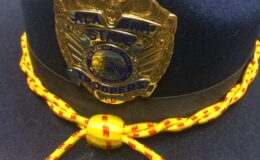
When Rosanne Martin received the results of an at-home DNA ancestry test, the results were pretty clear.
Her brother, who died in 2012, had a daughter Martin didn’t know about.
“We kind of figure he was about 18 when this child came to life,” Martin told Cross Country Checkup guest host Piya Chattopadhyay. “He might not even [have] known.”
The two women connected in May 2018 and to this day keep in touch. Martin says not only do they look alike, but they have similar mannerisms.
Her niece, who was born in 1975, had taken an ancestry test in an effort to find her biological father.
At-home DNA testing kits have become a mainstream product for offering a look into a user’s genetic heritage and even health pre-dispositions.
While they can offer insight into one’s lineage, the results are often an approximation of genetics combined with results from their database of customers.
“It’s pretty easy to identify siblings or first cousins in their database of participants,” said McGill University human genetics professor Simon Gravel.
“Once they go beyond very close relatives they try to do averages … they’ll build statistical models to try to tell you, you know, on average where they think your ancestors came from.”
Results change as databases grow
In the days before transatlantic travel, there wasn’t much human movement between continents.
As a result, DNA testing companies can provide fairly broad estimates of your heritage, such as “broadly European” or “broadly Asian”, says Gravel.
It’s when those results become more granular, pointing to specific countries and even specific regions, that things become tricky.
“If you try to give a specific country or a specific area — well, people have been moving around, you know, for thousands of years … so then it becomes very sensitive to know exactly who’s in their sample.”

Because the genetic databases held by companies offering genetic ancestry continuously grow, a person’s results can change.
As the sample size — and, crucially, geographic diversity — grow, companies recalibrate the algorithms that they use to determine your ancestral roots.
“Because, maybe your genetic ancestry is from a particular area that [they] didn’t have data for before, and now suddenly they have data from that part of the world, well now they’re going to change the way they report it to you.”
Ancestry is not identity
Kerry Bowman, a University of Toronto bioethicist, cautions that genetic tests can only provide information about your genealogical family tree — not the makeup of your identity.
“There’s, kind of, a presupposition with all of this that biology really, really determines your identity in a profound way,” he told Checkup.
“What about culture and emotional relationships, and those types of things?”

Indeed, one television ad from a leading ancestry company portrays a many who just discovered he has German ancestry wearing lederhosen.
Gravel shares the concern that some may attempt to use these test results to form their personal identity.
“Personally, as a geneticist, I don’t put any kind of weight on the genetic tests in terms of what it means for me and who I am as an individual,” he told Chattopadhyay.
“People really see this as science has spoken, but science has only spoken about, you know, who your relatives are.”
Recognize the limits
While Gravel recognizes the appeal of mapping one’s lineage, he encourages users to take the results with a grain of salt.
“It’s fine to be, for example, very excited to find that you have relatives in one part of the world that you didn’t know you have relatives,” he said. “But that’s all it says.”
For Martin, who cautions friends who might be worried about any potential skeletons in the closet from sampling their genome, it’s about going into it with an open mind.
“Our family has a pretty good attitude towards these things. It’s like, ‘Well that’s the past; it wasn’t us,'” she said. “We just welcome whoever, you know?”
“It was wonderful meeting my new niece.”












